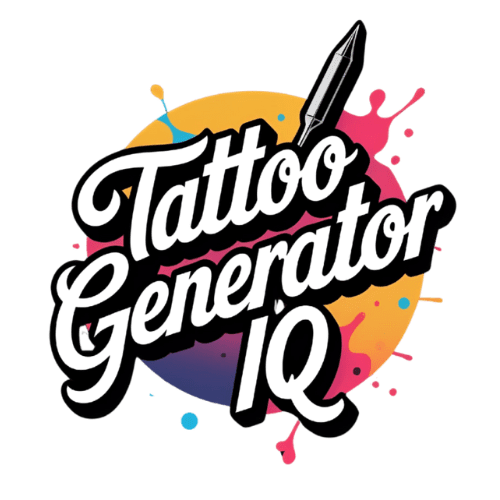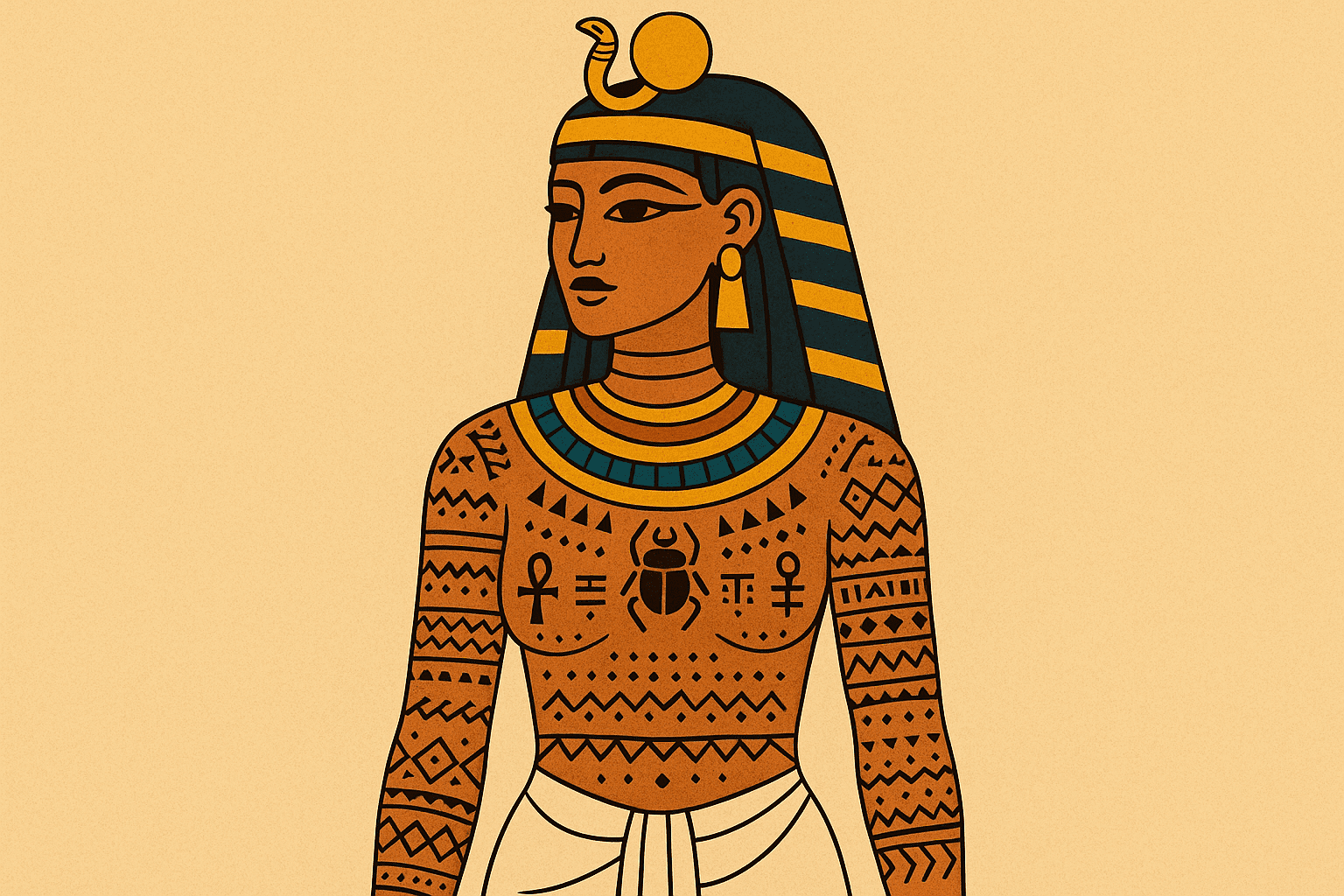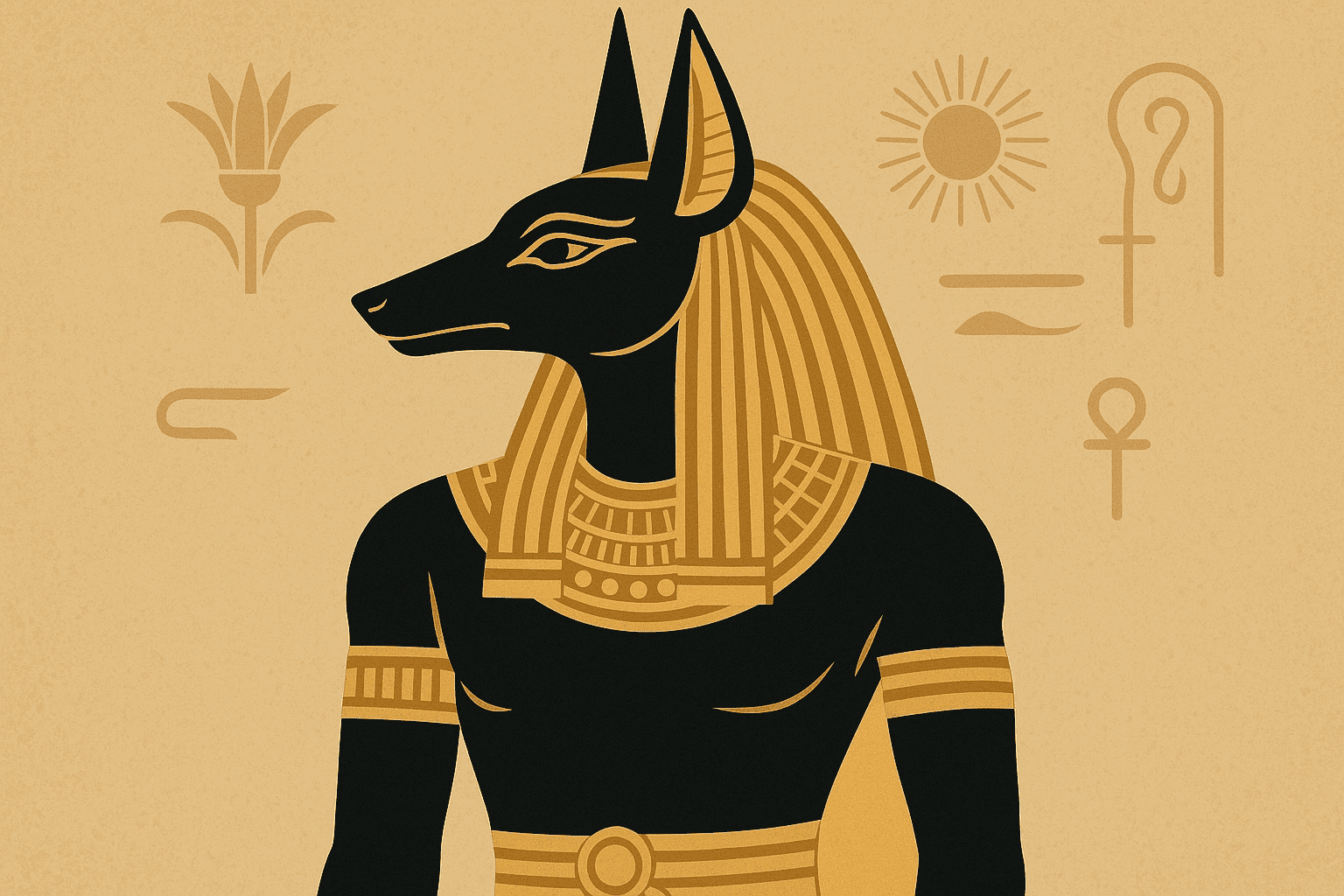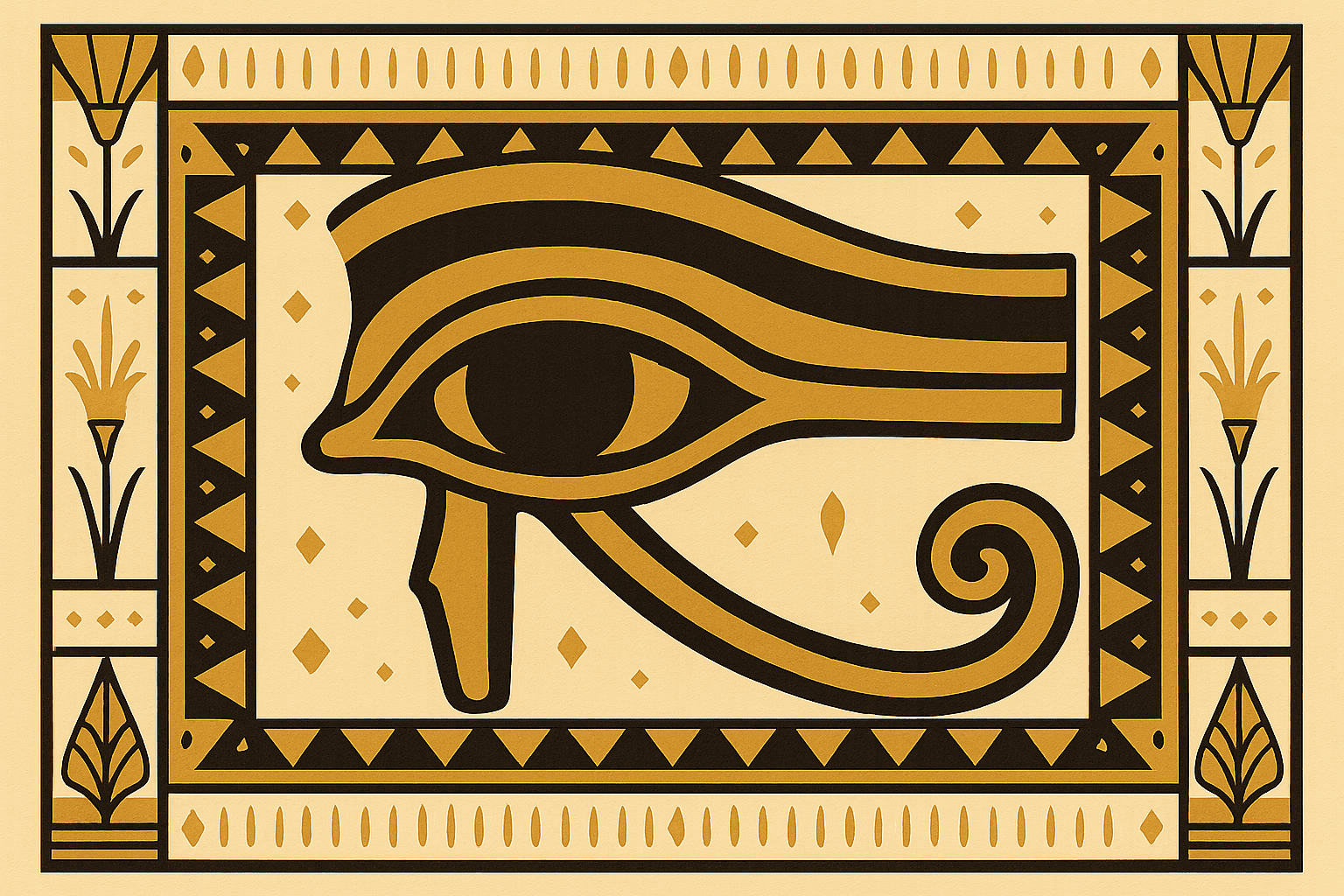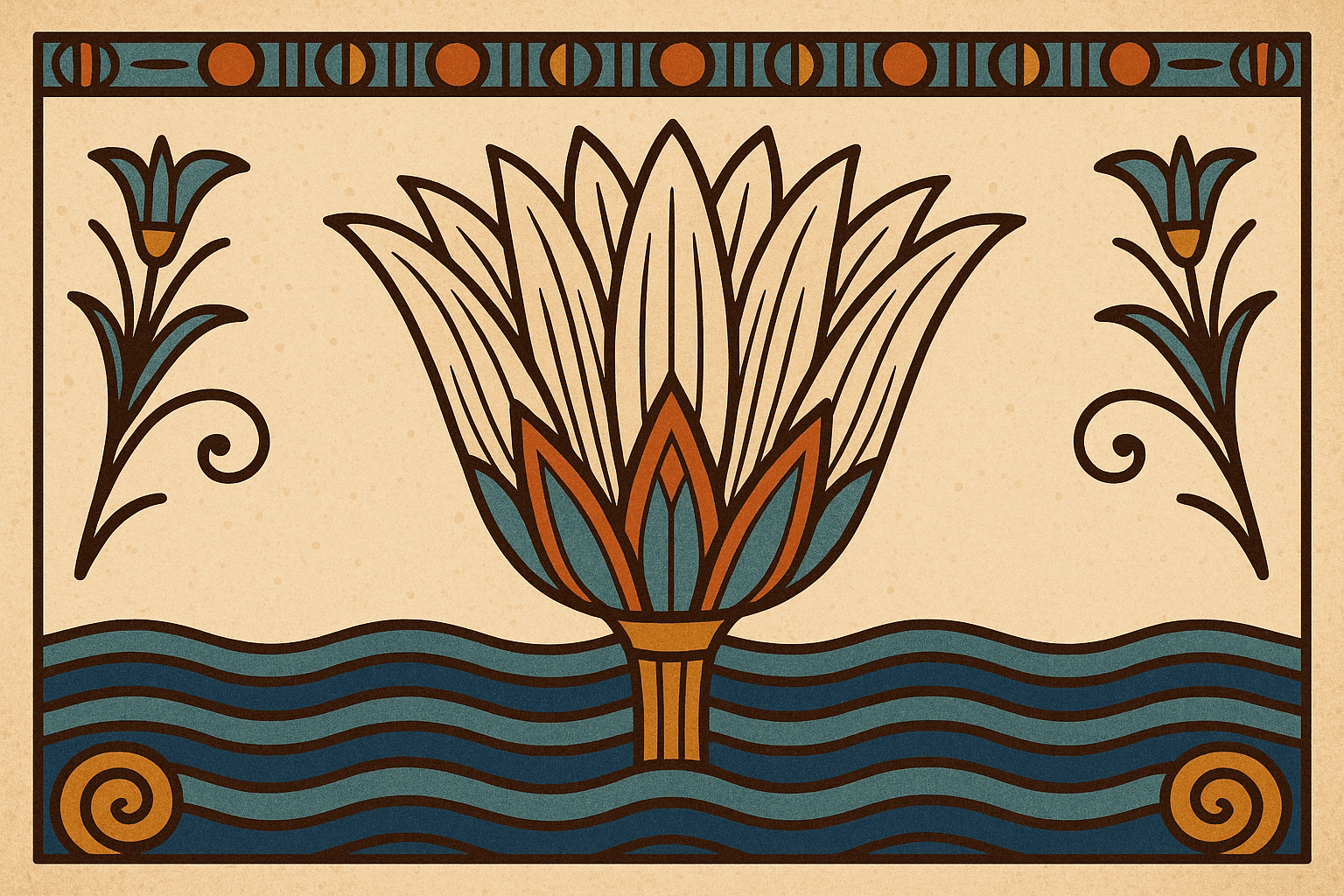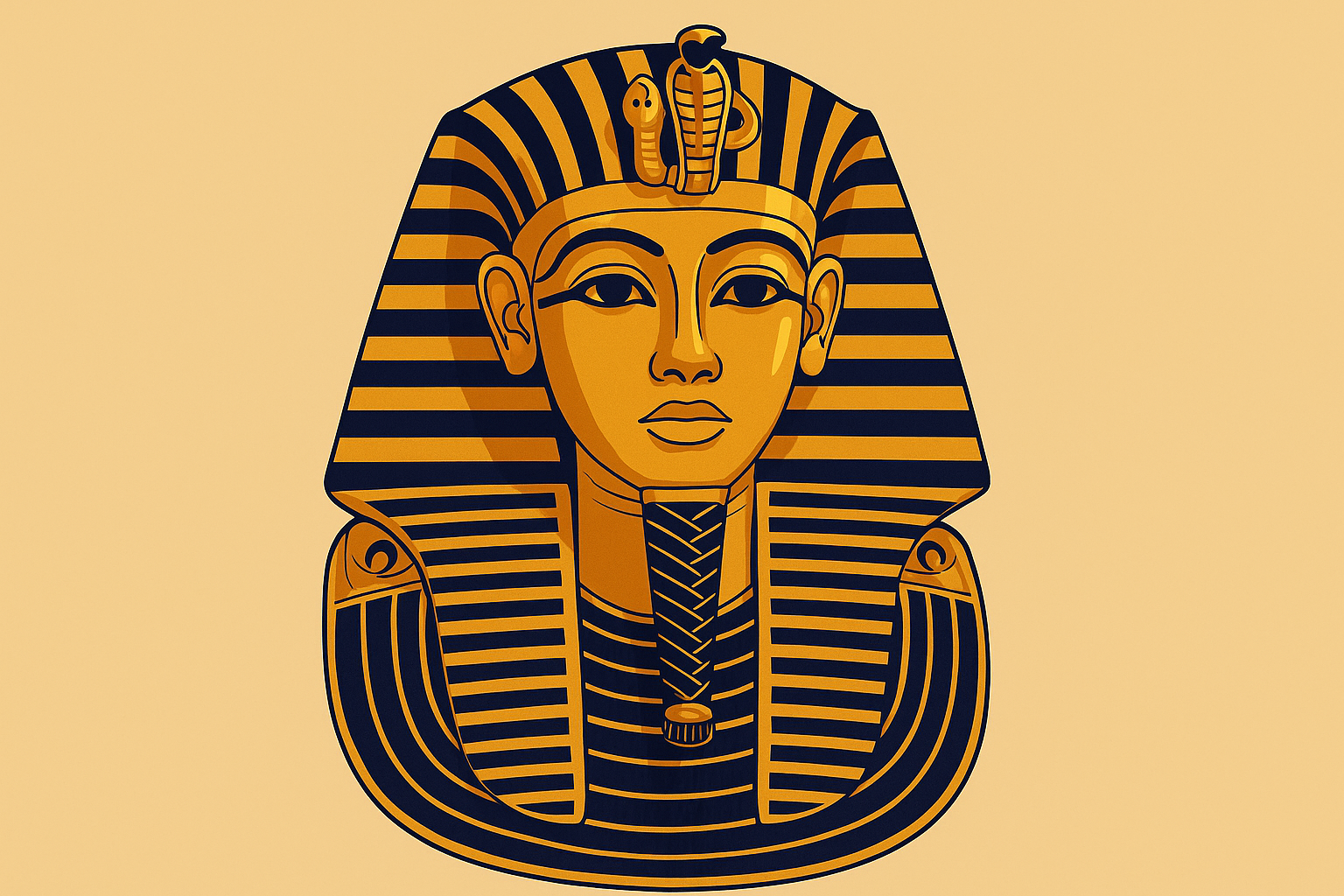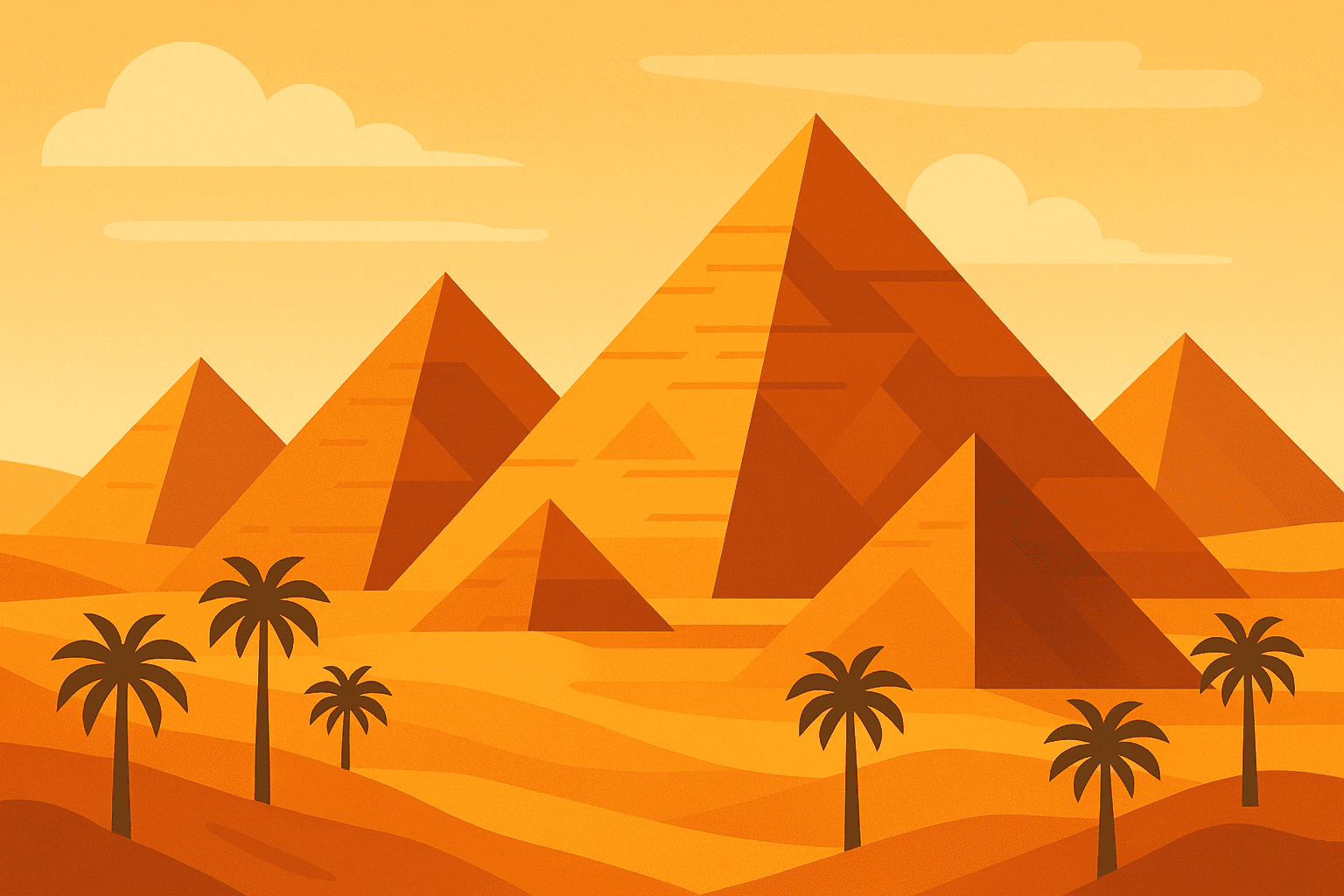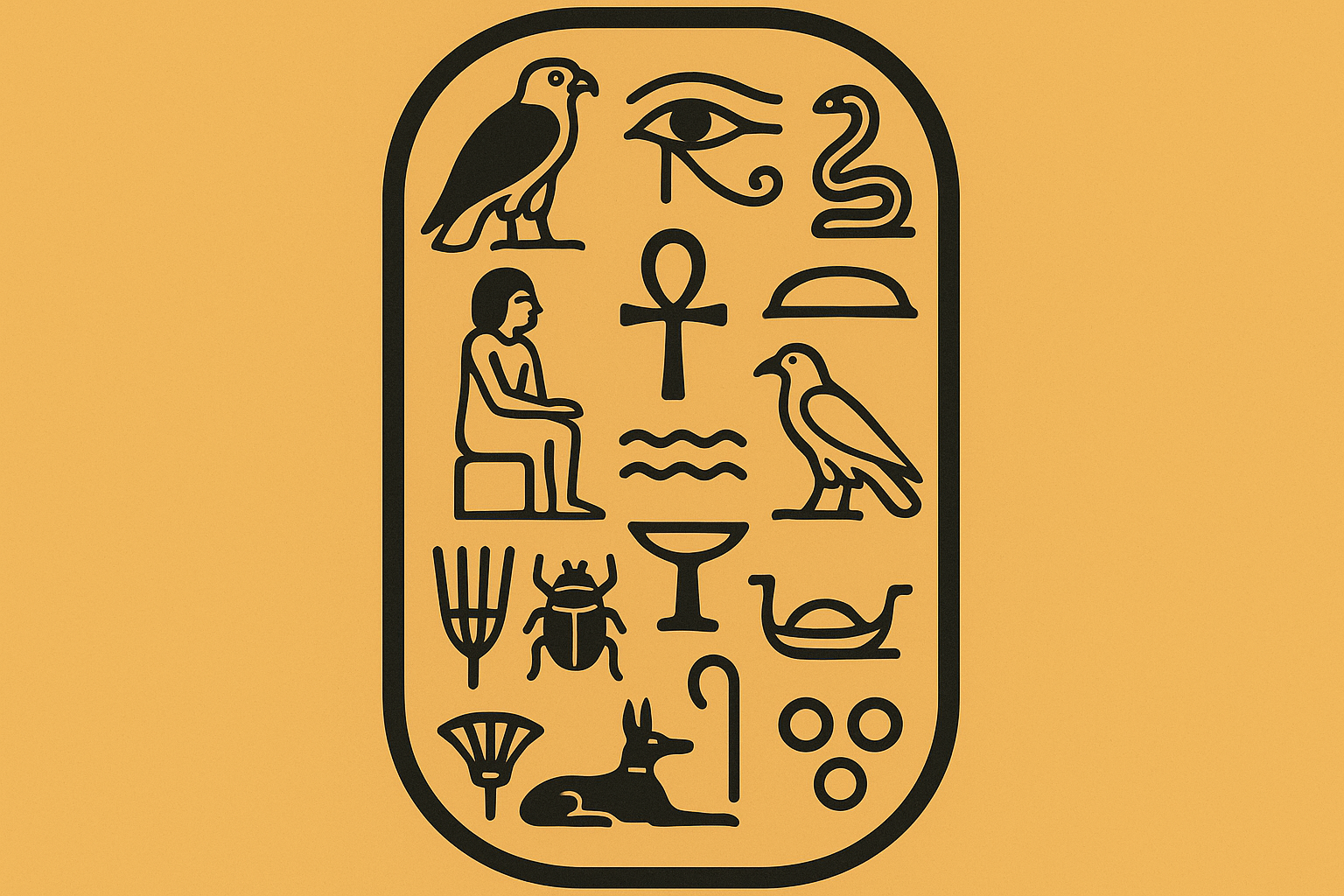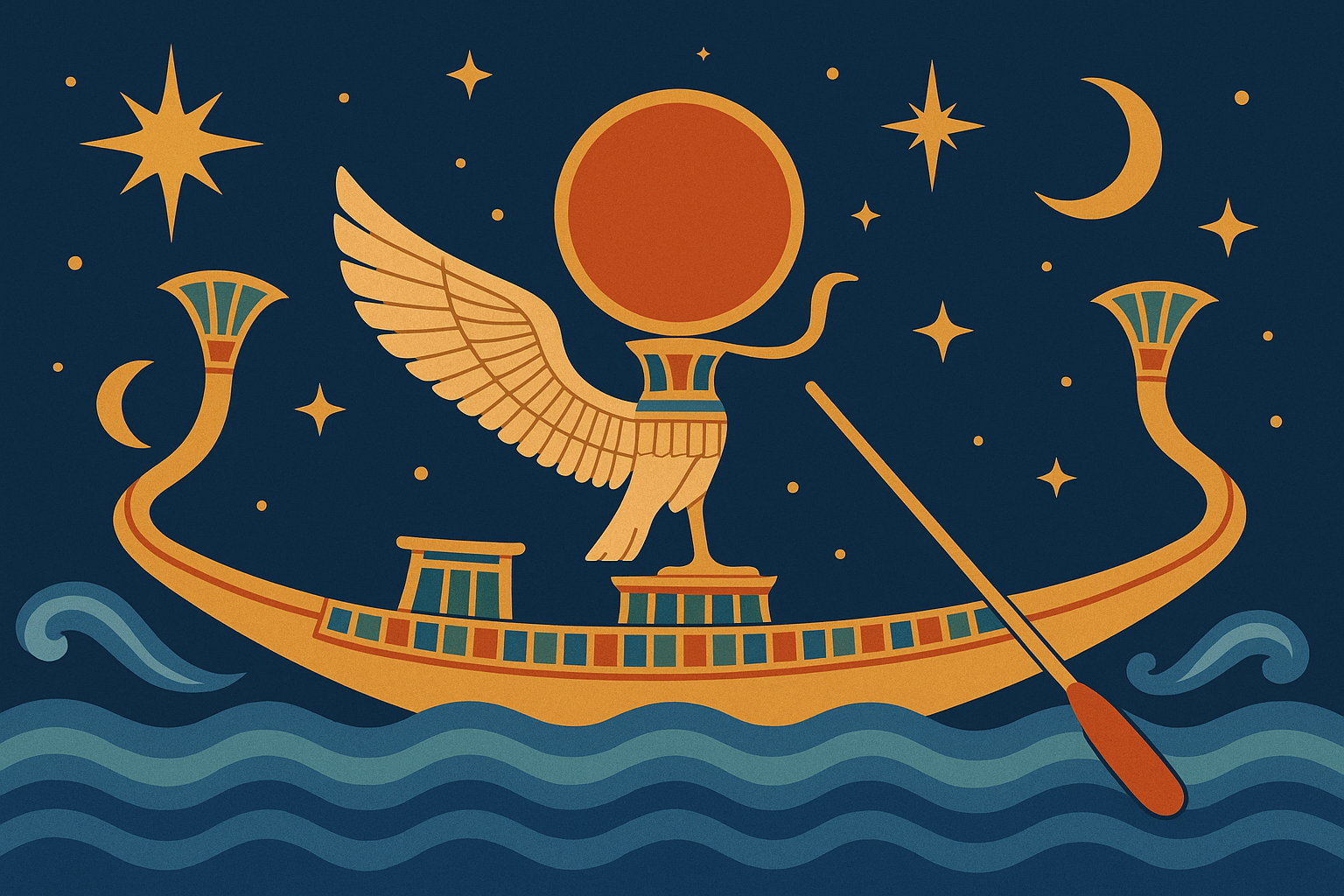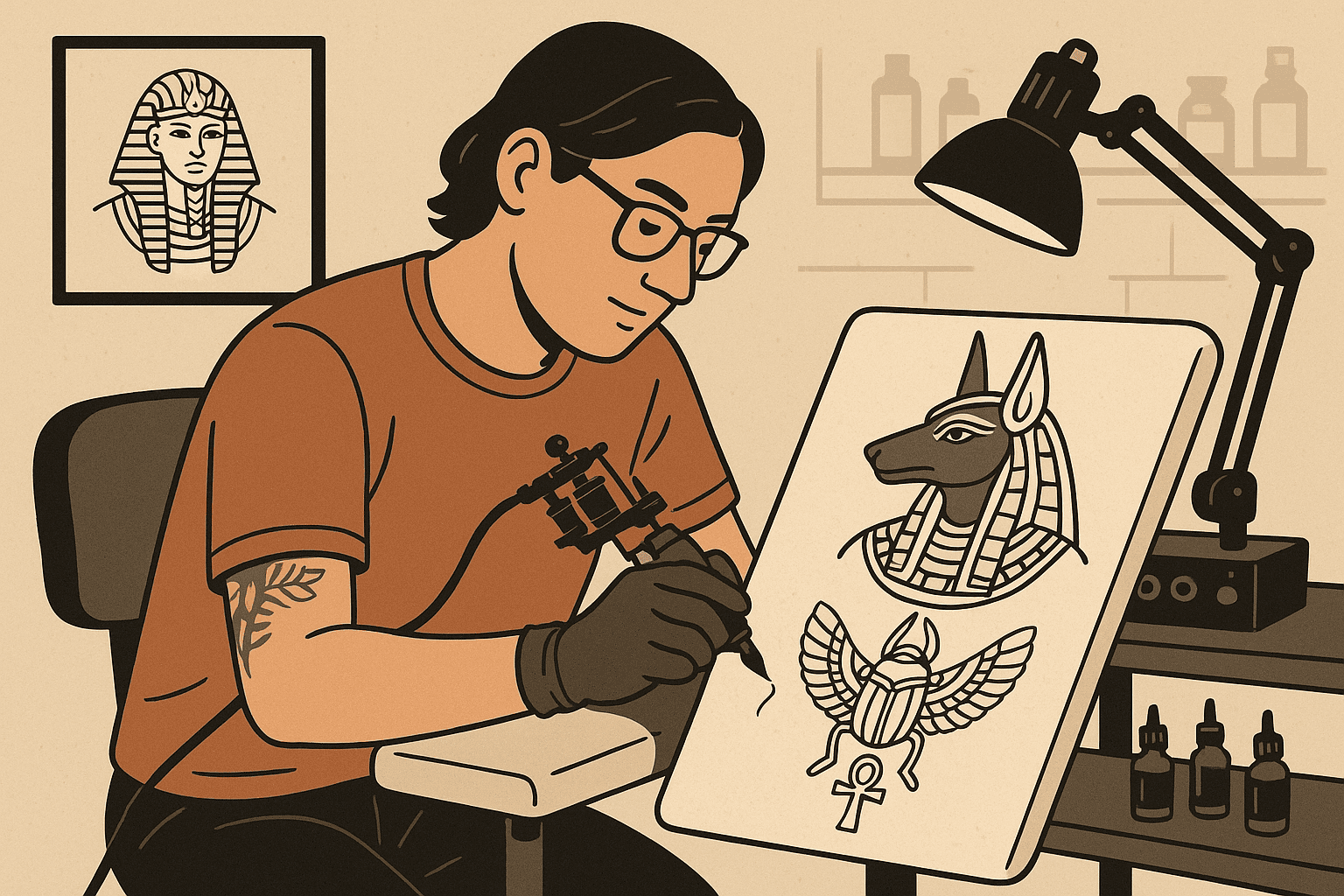25 Egyptian Tattoos That Will Transform Your Body Into Ancient Art
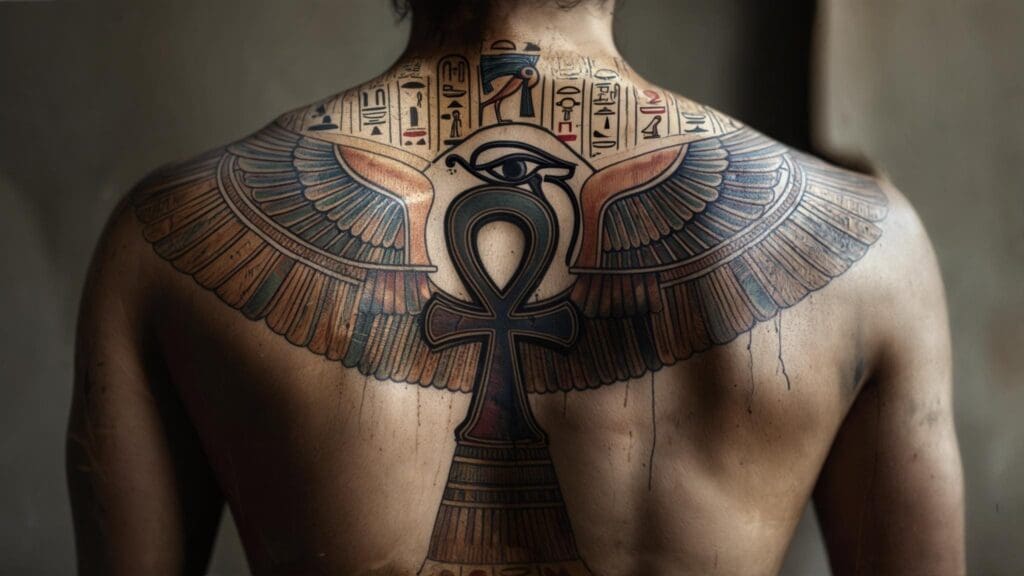
Egyptian tattoos blend ancient symbolism with modern artistry, offering designs from simple ankh symbols to complex Book of the Dead scenes. Archaeological evidence shows Egyptian tattooing dates back over 5,000 years, primarily found on priestesses and women of high status – which honestly makes me feel like I’m carrying on an ancient sisterhood tradition.
Look, diving into Egyptian tattoo culture is like opening a treasure chest of symbolism that’s been captivating people for millennia. Divine deities offer protection and spiritual guidance that feels incredibly relevant today. Sacred symbols like the Eye of Horus and ankh pack powerful meanings into compact, gorgeous designs. Royal elements including pharaoh masks require respectful treatment – we’re talking about sacred imagery here, not Halloween costumes.
Architectural designs featuring pyramids and temples work beautifully as statement pieces, but let’s be real about what you’re getting into. You’ll need to consider cultural respect (because nobody wants to be that person), design complexity (some of these require serious artistic chops), compatibility with your style, how they’ll age, and whether the symbolism actually resonates with your life story.
Here’s the truth about Egyptian tattoos: bold geometric symbols age like fine wine, while intricate portrait work and detailed hieroglyphs might need some TLC down the road.
Key Considerations for Egyptian Tattoo Selection
Before falling head-over-heels for that stunning Anubis design, let’s talk about five crucial factors that’ll determine whether you love your Egyptian tattoo for decades or end up with expensive regrets: cultural respect, design complexity, artistic compatibility, aging potential, and genuine personal connection.
Archaeological evidence reveals that Egyptian tattooing was practiced at least as early as the Middle Kingdom, with discoveries showing intricate patterns on priestesses and high-status women. I remember visiting the Egyptian wing of the Metropolitan Museum and being struck by how these ancient symbols still felt so alive and powerful – that’s exactly what you want your Egyptian tattoo to capture.
Egyptian symbols carry thousands of years of spiritual weight – we’re not talking about trendy flash art here. You’ll want to research the historical significance thoroughly because mixing incompatible religious elements is like wearing a tuxedo jacket with swim trunks. Stick to cohesive themes that honor the original context, and you’ll avoid those awkward “actually, that symbol means…” conversations.
Design complexity in Egyptian work ranges from “quick lunch break tattoo” to “I’m basically adopting my artist for the next six months.” Simple hieroglyphs can be knocked out in a single session, while elaborate temple scenes require master-level artists and the patience of a saint. Be honest about your pain tolerance, budget, and available skin real estate.
When planning your ancient Egyptian tattoo, understanding pain levels for different body placements helps you choose the ideal location without any nasty surprises. The ancient aesthetic plays beautifully with modern tattoo styles – traditional, neo-traditional, realism, and geometric approaches all work like magic with Egyptian imagery.
Here’s what nobody tells you: ancient Egyptian tattoos often feature fine lines and intricate details that can blur over time. Have an honest conversation with your artist about aging expectations and budget for potential touch-ups. Most importantly, your Egyptian tattoo should actually mean something to you beyond looking cool on Instagram. Whether you’re drawn to protection, wisdom, rebirth, or spiritual connection, make sure the symbol reflects your actual values and life experiences.
| Selection Criteria | Beginner Friendly | Moderate Experience | Advanced Collectors |
|---|---|---|---|
| Cultural Respect | Simple positive symbols (ankh, lotus) | Well-researched deity images | Complex religious scenes with proper context |
| Design Complexity | Single symbols, clean lines | Medium detail work, combined elements | Multi-figure compositions, intricate details |
| Time Investment | 1-3 hours | 4-8 hours | 10+ hours across multiple sessions |
| Budget Range | $200-500 | $500-1500 | $1500+ |
| Recommended Designs | Eye of Horus, Ankh, Scarab | Anubis, Bastet, Pyramid | Book of the Dead, Temple Complex |
Divine Deities
Egyptian deities offer some of the most powerful and recognizable tattoo designs, each carrying specific protective and spiritual meanings that still hit hard today. These five divine figures – Anubis, Bastet, Horus, Isis, and Thoth – represent different aspects of ancient Egyptian spirituality while translating beautifully into modern tattoo art with their distinctive iconography and rich symbolism.
1. Anubis – The Guardian of the Afterlife
Complexity: High
Okay, let’s talk about Anubis – this guy is seriously no joke. I’ve watched grown men tear up getting this tattoo, not because of the pain, but because something about that watchful jackal face just hits different. If you’re going through a major life change – divorce, career switch, loss of a loved one – Anubis feels like having an ancient bodyguard watching your back.
Design Elements: The detailed jackal head with those alert, perked ears sits atop a human torso, usually decked out in traditional Egyptian gear. You’ll often see religious symbols like the ankh, was scepter, or scales of justice hanging out nearby, while hieroglyphic backgrounds add that authentic ancient vibe.
Placement Options: Back pieces let Anubis rule in all his glory, while chest, upper arm, and thigh spots work beautifully for medium-sized versions. For those wondering about the investment, understanding tattoo pricing factors helps budget for this complex piece properly – we’re talking serious money here.
Color Schemes: Traditional black and gold creates that classic, timeless appeal. Full color with blues and golds offers regal beauty that’ll make people stop and stare. Black and grey provides striking elegance that ages like a dream.
This design scores maximum points for cultural respect and personal connection. The complexity demands an experienced artist – don’t cheap out here – but the results age reasonably well thanks to those strong structural elements.
Real-World Application: Sarah, a hospice nurse from Portland, chose an Anubis design for her upper back after losing her grandmother. The jackal-headed god’s role as protector of souls in transition resonated deeply with her work helping families through end-of-life care. Her artist incorporated subtle scales of justice in the background, representing the weighing of hearts in the afterlife. The piece took 12 hours across three sessions and has become a source of strength during difficult cases. She says people often ask about it, giving her opportunities to share both the ancient meaning and her personal connection.
2. Bastet – The Cat Goddess of Protection
Complexity: Medium to High
Bastet brings feline grace and protective power that resonates incredibly strongly with modern audiences, especially if you’re already a crazy cat person or feel drawn to that fierce maternal protection energy.
Design Elements: Cat heads or full feline forms adorned with Egyptian jewelry create absolutely stunning focal points. Protective symbols and lunar elements enhance that mystical quality, while realistic fur textures add depth that’ll make you want to pet your own tattoo.
Placement Options: Forearms display the design beautifully – perfect for showing off those feline features. Shoulders, backs, and ribcages accommodate larger interpretations if you want to go big.
Variations: Choose from realistic cat portraits that could be your actual pet, anthropomorphic goddess figures with that ancient Egyptian flair, or minimalist silhouettes for a more subtle approach. Cat imagery ages exceptionally well in tattoo form, making Bastet an excellent long-term choice that won’t leave you with regrets.
3. Horus – The Sky God’s Watchful Eye
Complexity: Medium to High
Horus soars above other Egyptian deities when it comes to visual impact. The falcon-headed sky god embodies divine kingship and protective oversight – perfect for natural leaders or anyone working on developing those leadership qualities.
Design Elements: Falcon heads with distinctive eye markings create immediate recognition factor. Royal regalia, the Eye of Horus, solar disks, and spread wings add layers of meaning and serious visual punch.
Placement Options: Chest and back placements emphasize the god’s majesty and give you room to really showcase those wings. Upper arms and shoulder blades work well for medium-sized designs that still pack a punch.
Style Variations: Realistic falcon portraits capture natural beauty that bird lovers adore. Traditional Egyptian art styles honor ancient aesthetics perfectly. Modern geometric interpretations offer contemporary appeal for those wanting something fresh.
The strong silhouette ages well, though fine feather details might need occasional touch-ups. This ancient Egyptian tattoo works best in realistic and traditional tattoo styles.
4. Isis – The Mother Goddess
Complexity: High
Isis embodies the ultimate feminine divine power in Egyptian mythology. Her protective wings and magical abilities make her an inspiring choice for women embracing their strength or anyone seeking that maternal protection and healing energy.
Design Elements: Winged female figures create absolutely dramatic compositions that command attention. Throne headdresses, ankh symbols, protective gestures, and flowing robes add authenticity and gorgeous visual flow.
Placement Options: Back pieces allow those wings to spread in full glory – we’re talking show-stopping artwork here. Ribcages, thighs, and upper arms accommodate various size interpretations depending on your commitment level.
Artistic Approaches: Classical Egyptian art styles honor tradition beautifully. Realistic portraiture adds modern appeal that photographs amazingly. Art nouveau influences create unique interpretations that stand out from the crowd.
Large-scale Isis designs age better than fine detail work. Those intricate wing patterns require exceptional artistic skill, but when done right, they create absolutely breathtaking results that’ll have people asking for your artist’s info.
5. Thoth – The God of Wisdom
Complexity: Medium to High
Thoth speaks to the scholar in all of us. The ibis-headed god of wisdom and writing resonates with educators, writers, students, and anyone who values knowledge and truth above material possessions – basically, the nerds of the world, and we love that.
Design Elements: That distinctive curved ibis beak requires careful artistic execution to avoid looking like a wonky bird. Scribal palettes, reed pens, scales of justice, and moon disks add layers of meaning related to wisdom and judgment.
Placement Options: Forearms display the design prominently – perfect for those “yes, I’m smart” moments. Upper backs, shoulders, and calves offer good alternatives for various sizes and orientations.
Design Variations: Portrait styles focus on the god’s distinctive features. Full-body figures show complete regalia for maximum impact. Symbolic representations incorporating books or scrolls add modern relevance for the book lovers.
Clean lines age beautifully in Thoth designs, though fine details may need periodic touch-ups. The design works excellently in realistic and illustrative tattoo styles.
Sacred Symbols
Sacred Egyptian symbols offer the most versatile tattoo options, ranging from simple designs perfect for beginners to elaborate interpretations for experienced collectors. These eight powerful symbols – including the Eye of Horus, ankh, and scarab beetle – carry deep spiritual meanings while adapting beautifully to various artistic styles and placement options.
6. Eye of Horus (Wadjet)
Complexity: Low to Medium
The Eye of Horus is Egypt’s most recognizable protective symbol, and honestly, it’s like the little black dress of Egyptian tattoos – classic, versatile, and never goes out of style. Its distinctive shape and powerful meaning make it perfect for first-time Egyptian tattoo enthusiasts or as an accent piece in larger compositions.
Design Elements: That characteristic eye shape with decorative markings below creates instant recognition – people will know what it is immediately. Geometric patterns or hieroglyphic elements can enhance the basic design without overwhelming its beautiful simplicity.
Placement Options: Small versions work beautifully behind ears, on wrists, or ankles for that subtle mystical vibe. Medium sizes suit chests perfectly. Larger interpretations can grace backs or necks for those wanting to make a statement.
Size Variations: Minimalist versions offer subtle elegance for the understated crowd. Medium detailed designs provide good balance between impact and subtlety. Large elaborate interpretations make bold statements that command attention.
This symbol scores perfectly across all criteria – it’s culturally respectful, adaptable to any artistic style, ages excellently due to those bold shapes, and offers universal appeal for protection and insight.
7. Ankh – The Key of Life
Complexity: Low
The ankh’s elegant simplicity makes it the perfect gateway drug into Egyptian tattoo symbolism. This key of life carries profound meaning about eternity and divine protection while remaining beautifully uncomplicated in execution – basically, it’s foolproof.
Design Elements: The basic cross with loop top can stand alone in all its simple glory, or be decorated with patterns, hieroglyphs, or combined with other meaningful symbols like names or important dates.
Placement Options: The ankh’s versatility means it works literally anywhere on your body. Popular spots include behind ears for that subtle surprise, wrists for daily reminders, ankles for beachy vibes, and as part of larger compositions where it plays well with others.
Variations: Plain black outlines offer classic appeal that never gets old. Detailed patterns add visual interest for those wanting something more elaborate. Combinations with personal elements create unique meaning that’s all yours.
Perfect scores across all evaluation criteria make the ankh an ideal choice. It’s universally positive, extremely simple for beginners, works in any artistic style, ages perfectly , and carries universal life-affirming symbolism.
8. Djed Pillar – Symbol of Stability
Complexity: Low to Medium
The djed pillar speaks to anyone who’s weathered life’s storms and emerged stronger. This symbol of stability and endurance resonates particularly well with people who’ve overcome significant challenges or value resilience above all else – basically, the survivors among us.
Design Elements: The vertical pillar with horizontal crossbars creates clean, architectural lines that photograph beautifully. Hieroglyphic text or decorative elements can enhance the basic structure without compromising its powerful simplicity.
Placement Options: Spine placements emphasize that backbone symbolism perfectly – literally wearing your strength on your spine. Forearms, calves, and ribcages offer excellent alternatives for various orientations.
Design Approaches: Simple geometric forms honor the symbol’s architectural nature. Ornate versions with Egyptian patterns add visual richness for those wanting more detail. Combinations with other stability symbols create personal meaning.
Strong vertical lines age excellently, making this a smart long-term choice. The design works particularly well in geometric and traditional tattoo styles.
9. Was Scepter – Symbol of Power
Complexity: Medium
The was scepter embodies divine authority and control over chaos – perfect for natural leaders, entrepreneurs, and anyone working to establish their personal authority in challenging situations. It’s basically the ancient Egyptian power suit.
Design Elements: The staff’s curved top and forked bottom create distinctive silhouettes that stand out. Animal heads (often canine) add detail and meaning, while decorative shaft patterns enhance visual appeal.
Placement Options: Forearms and calves showcase the scepter’s length beautifully, giving it room to breathe. Backs and thighs accommodate larger, more detailed versions for those going all-out.
Variations: Realistic detailed versions honor historical accuracy for the history buffs. Stylized geometric interpretations offer modern appeal. Combinations with other royal symbols create comprehensive power themes.
This royal symbol requires thoughtful use to maintain cultural respect. The detailed animal head work demands skilled artistry, but the strong linear design ages well over time.
10. Scarab Beetle
Complexity: Medium
The scarab beetle carries profound transformation symbolism that hits hard for anyone who’s experienced major life changes. This protective symbol represents the soul’s journey through death and rebirth – perfect for marking personal transformations, recovery milestones, or major life pivots.
Design Elements: Detailed beetle forms with spread wings create dynamic compositions that seem to move. Geometric patterns on shells add visual interest, while solar disks above emphasize the connection to rebirth and renewal.
Placement Options: Chests and upper backs showcase those spread wings beautifully – we’re talking serious visual impact. Shoulders and thighs work well for more compact versions that still pack meaning.
Artistic Styles: Realistic insect portrayals capture natural beauty for bug enthusiasts. Stylized Egyptian art honors ancient traditions perfectly. Geometric modern interpretations offer contemporary appeal for those wanting something fresh.
The scarab scores excellently for positive transformation symbolism. This ancient Egyptian tattoo requires detailed wing and shell patterns that demand skilled artistry, but the good overall structure ages reasonably well, though fine details may fade over time.
For those considering their first ancient Egyptian tattoo, exploring simple tattoo designs helps understand how Egyptian symbols can work as starter pieces.
Real-World Application: Marcus, a recovery counselor from Denver, chose a scarab beetle design for his chest after celebrating five years of sobriety. The transformation symbolism perfectly captured his journey from addiction to helping others recover. His artist incorporated subtle geometric patterns on the beetle’s wings and added a small solar disk above, representing daily renewal. The piece serves as a daily reminder of his transformation and inspires the clients he works with. He jokes that explaining the symbolism has become part of his recovery story.
11. Tyet (Isis Knot)
Complexity: Low to Medium
The tyet channels Isis’s protective feminine power into a compact, elegant symbol. Often called the “knot of Isis,” this design resonates strongly with women seeking spiritual protection and empowerment – it’s like having a goddess in your corner.
Design Elements: The knotted loop structure resembles the ankh but with arms folded downward, creating a more intricate silhouette. Decorative patterns can enhance the basic form, and combinations with other feminine elements create personalized meaning.
Placement Options: Wrists, ankles, and behind-ear placements work perfectly for smaller versions that whisper rather than shout. Ribcages accommodate larger interpretations for those wanting more impact.
Design Variations: Simple line work maintains elegant minimalism. Ornate patterns add visual richness for those wanting more detail. Combinations with feminine elements create unique personal statements.
This positive feminine protective symbol earns high marks across all criteria. The moderate knot detail requires some artistic skill, but clean lines age well over time.
12. Lotus Flower
Complexity: Medium
The lotus flower embodies spiritual awakening and daily renewal – honestly, it’s like the ultimate symbol for anyone on a personal growth journey. In Egyptian mythology, it represents creation and the sun god Ra’s daily rebirth, making it perfect for those embracing transformation and spiritual development.
Design Elements: Detailed flower petals create organic beauty, often emerging from water to emphasize those rebirth themes. Solar elements or hieroglyphs can add deeper Egyptian context without overwhelming the natural beauty.
Placement Options: Shoulders and forearms display the flower beautifully, giving it room to bloom. Ankles, backs, and thighs offer alternatives for various sizes and orientations.
Style Options: Realistic botanical illustrations capture natural beauty for plant lovers. Stylized Egyptian art honors ancient traditions. Watercolor techniques add modern artistic flair that photographs amazingly.
This universal symbol of growth and purity adapts to many artistic styles. Detailed petal work requires skilled artistry, and while organic shapes age well, fine details may need occasional touch-ups.
13. Cartouche with Hieroglyphs
Complexity: Medium to High
Cartouches originally framed the names of Egyptian royalty in hieroglyphic script. Modern interpretations let you immortalize personal names, meaningful words, or important phrases in ancient Egyptian writing – just please, for the love of all that’s holy, get them translated properly first.
Design Elements: Oval borders contain hieroglyphic symbols with decorative frame elements. The content should carry personal significance – names, meaningful words, family connections, or important dates that actually matter to you.
Placement Options: Forearms showcase the horizontal layout perfectly, making it easy to show off. Ribcages, upper backs, and thighs accommodate various sizes and orientations.
Customization: Personal name translations create intimate meaning. Meaningful words add philosophical depth. Family names honor heritage. Important dates mark significant moments that shaped you.
This royal symbol requires respectful use and accurate hieroglyphic translation – seriously, triple-check this stuff. The detailed symbol work demands skilled artistry, and while the overall structure ages well, small hieroglyphs may blur into ancient chicken scratch over time.
| Symbol | Complexity | Time Required | Best Placement | Aging Quality | Personal Meaning |
|---|---|---|---|---|---|
| Eye of Horus | Low-Medium | 2-4 hours | Wrist, Chest, Behind ear | Excellent | Protection, insight |
| Ankh | Low | 1-2 hours | Anywhere | Excellent | Eternal life, divine protection |
| Scarab Beetle | Medium | 3-6 hours | Chest, Shoulder | Good | Transformation, rebirth |
| Lotus Flower | Medium | 3-5 hours | Forearm, Shoulder | Good | Spiritual awakening, purity |
| Cartouche | Medium-High | 4-8 hours | Forearm, Ribcage | Fair | Personal identity, royal connection |
Royal and Pharaonic Elements
Royal Egyptian elements represent the pinnacle of ancient power and divine authority, requiring respectful treatment because we’re talking about sacred imagery here, not costume party decorations. These five designs – from Tutankhamun’s death mask to various crown combinations – appeal to those drawn to Egyptian history and royal symbolism while demanding exceptional artistic skill for proper execution.
14. Pharaoh’s Death Mask
Complexity: High
Tutankhamun’s golden death mask remains one of history’s most recognizable artifacts, and getting it tattooed is like wearing a piece of art history on your skin. This Egyptian tattoo captures eternal kingship and divine protection while honoring one of archaeology’s greatest discoveries.
Design Elements: Detailed facial features require exceptional portrait skills – we’re talking master-level artistry here. The striped nemes headdress, cobra and vulture symbols (uraeus), intricate collar work, and golden coloring create complex layered compositions that’ll make people stop and stare.
Placement Options: Chest and upper back placements showcase the mask’s majesty and give you room for all those incredible details. Thighs and full sleeve components allow for detailed work without cramping the design.
Artistic Approaches: Photorealistic portraits capture historical accuracy for the history buffs. Stylized traditional Egyptian art honors ancient aesthetics. Modern geometric interpretations offer contemporary appeal for those wanting something fresh.
This iconic royal symbol requires respectful treatment – no adding sunglasses or making it “funny.” The extremely detailed facial work and ornate decorative elements demand master-level artistry, though fine facial details may blur over time and need touch-ups.
15. Cleopatra Portrait
Complexity: High
Cleopatra embodies feminine power, intelligence, and political mastery like nobody else in history. Her legendary status makes her perfect for women embracing leadership roles or anyone inspired by her remarkable historical achievements – she’s basically the ultimate boss lady.
Design Elements: Detailed facial portraits require exceptional skill – don’t trust this to your buddy’s cousin who just bought a tattoo gun. Elaborate headdresses, Egyptian jewelry, dramatically kohl-lined eyes, and royal regalia create rich, complex compositions.
Placement Options: Upper arms, backs, thighs, and ribcages provide adequate space for detailed portrait work that does justice to the queen herself.
Style Variations: Classical beauty interpretations emphasize timeless appeal. Historically accurate versions honor archaeological evidence. Modern artistic interpretations allow creative freedom while maintaining respect.
This historical figure carries positive associations of female empowerment. Portrait work requires exceptional artistic skill and ages moderately well, though fine details need maintenance over time.
16. Nemes Headdress
Complexity: Medium
The nemes headdress instantly communicates royal authority and divine kingship. This striped royal headwear worn by pharaohs creates powerful symbolism for natural leaders and those developing leadership qualities – it’s like wearing a crown that actually means something.
Design Elements: Distinctive striped patterns require geometric precision – sloppy lines will make this look like a traffic cone. Cobra uraeus at the forehead, side wings, and accurate proportions create authentic representations.
Placement Options: Head/scalp placements make incredibly bold statements (though seriously consider your career first). Upper arms, backs, and chests offer more conventional options that still pack punch.
Design Approaches: Geometric pattern focus emphasizes the design’s architectural nature. Combinations with skull imagery add modern edge for those wanting something edgier. Integration into larger Egyptian scenes creates comprehensive compositions.
This royal symbol requires respectful treatment and understanding of its sacred nature. Precise geometric striping demands skilled execution, but strong patterns age well over time.
17. Uraeus (Cobra Crown)
Complexity: Medium
The uraeus cobra symbolizes divine protection and royal authority. Worn on pharaohs’ foreheads, this striking serpent offers powerful protective symbolism for anyone facing challenges or seeking personal empowerment – it’s like having a guardian snake watching your back.
Design Elements: Coiled cobras in striking positions create dynamic energy that seems to move. Detailed scale work, spread hoods, and solar disks add authenticity and serious visual impact.
Placement Options: Forehead placements make bold statements (again, consider your day job). Necks, wrists, ankles, and behind-ear locations offer more subtle options.
Variations: Realistic snake portrayals capture natural beauty. Stylized Egyptian art honors ancient traditions. Geometric modern versions offer contemporary appeal.
This protective royal symbol requires thoughtful use and cultural understanding. Detailed scale work and cobra anatomy demand skilled artistry, but snake imagery generally ages well.
18. Egyptian Crown Combination
Complexity: High
Egyptian crowns carry specific historical meanings that require research and understanding – don’t just pick one because it looks cool. The Red Crown of Lower Egypt, White Crown of Upper Egypt, and Double Crown each represent different aspects of pharaonic power.
Design Elements: Distinctive crown shapes vary significantly between types, so accuracy matters. Ceremonial elements and combinations with other royal symbols create comprehensive royal themes.
Placement Options: Upper arms, backs, chests, and thighs provide adequate space for detailed crown work that does justice to the complexity.
Historical Accuracy: Research specific crown meanings thoroughly. Understand appropriate combinations. Respect the historical context of each crown type – this isn’t mix-and-match time.
These royal symbols require historical understanding and respectful treatment. Complex shapes and accuracy demands require exceptional artistic skill, but bold crown forms age reasonably well.
Architectural and Cultural Elements
Egyptian architectural elements offer some of the most visually striking tattoo designs, from simple geometric pyramids to elaborate temple complexes. These four designs celebrate Egypt’s architectural marvels while providing excellent options for large-scale tattoo work that ages exceptionally well due to strong geometric foundations.
19. Pyramid Complex
Complexity: High
Pyramid complexes represent humanity’s greatest architectural achievements, and honestly, they never get old. These ancient Egyptian tattoos can range from minimalist geometric forms to elaborate desert landscapes complete with multiple pyramids, sphinx guardians, and atmospheric details that’ll transport you straight to Giza.
Design Elements: Geometric pyramid shapes provide strong foundations that photograph beautifully. Desert settings, palm trees, camels, sphinx figures, and hieroglyphic details add layers of authenticity and visual interest that tell a complete story.
Placement Options: Back pieces and chests accommodate elaborate complexes – we’re talking museum-quality artwork here. Full sleeves and thighs work well for medium-scale interpretations that still pack serious punch.
Style Options: Minimalist geometric approaches emphasize clean lines for the modern crowd. Detailed landscapes capture environmental beauty. Sunset/sunrise scenes add dramatic lighting effects that’ll make people stop scrolling.
These architectural marvels carry universal positive associations with human achievement and ancient mysteries. Large-scale detailed work requires significant time investment and deep pockets, but strong geometric shapes age excellently.
When planning elaborate Egyptian tattoos such as pyramid complexes, understanding chest tattoo pricing helps budget for these large-scale architectural pieces – spoiler alert: it’s expensive.
Real-World Application: David, an architect from Chicago, commissioned a pyramid complex design for his full back after visiting Giza. The piece features three pyramids with accurate proportional relationships, a detailed sphinx guardian, and subtle hieroglyphic elements around the borders. His artist spent considerable time researching architectural accuracy, and the geometric nature of the design has aged beautifully over eight years. The tattoo often sparks conversations about ancient engineering marvels with his colleagues and clients. He says it’s become his favorite conversation starter at professional events.
20. Sphinx Guardian
Complexity: High
The sphinx embodies the perfect fusion of human wisdom and animal strength – basically, it’s the ultimate symbol of being both smart and badass. This mysterious guardian protects sacred knowledge while representing the balance between intellectual and physical power.
Design Elements: Human heads on lion bodies create challenging anatomical combinations that require serious artistic chops. Detailed facial features, powerful lion physiques, and pyramid backgrounds add context and visual impact.
Placement Options: Backs, chests, thighs, and full sleeve components provide adequate space for the sphinx’s impressive proportions and majestic presence.
Artistic Approaches: Realistic sculpture-inspired interpretations honor the original monuments. Ancient weathered appearances add historical authenticity. Modern artistic interpretations allow creative freedom while maintaining respect.
This positive guardian symbol represents wisdom and protection. Complex anatomy combining human and animal features demands exceptional artistic skill, but large-scale designs age better than fine details.
21. Temple Columns and Architecture
Complexity: Medium to High
Egyptian temple columns showcase the civilization’s architectural mastery in ways that still blow minds today. Their distinctive papyrus and lotus capitals represent growth, stability, and the connection between earth and divine realms – it’s like having ancient architecture permanently displayed on your body.
Design Elements: Detailed column capitals require architectural accuracy – sloppy proportions will make these look like wonky fence posts. Hieroglyphic inscriptions, architectural perspective, and temple settings add authenticity and visual depth.
Placement Options: Forearms and calves work perfectly for single columns, showcasing the vertical lines beautifully. Backs and ribcages accommodate multiple column compositions for those going all-out.
Design Focus: Architectural accuracy honors historical precedent for the history nerds. Artistic interpretations allow creative freedom. Combinations with other Egyptian elements create comprehensive themes.
These architectural elements carry positive spiritual associations with sacred spaces. Detailed architectural work and perspective require skilled artistry, but strong linear designs age well.
22. Hieroglyphic Panels
Complexity: Medium
Hieroglyphic panels transform personal messages into ancient Egyptian script – just please, for everyone’s sake, triple-check those translations. These designs can tell stories, convey blessings, or immortalize meaningful phrases in one of history’s most beautiful writing systems, connecting to the tradition of tattoos in ancient Egypt.
Design Elements: Accurate hieroglyphic symbols require careful research and translation – seriously, get a second opinion. Cartouche frames, decorative borders, and meaningful text content create authentic compositions.
Placement Options: Forearms showcase horizontal text beautifully, perfect for showing off your ancient wisdom. Ribcages, backs, and wrap-around designs accommodate longer inscriptions.
Content Options: Personal names create intimate connections. Meaningful phrases add philosophical depth. Ancient prayers honor spiritual traditions. Historical quotes connect to Egyptian wisdom.
Accurate translation and respectful content are essential for cultural sensitivity. Detailed symbol work requires historical accuracy and skilled execution, though small hieroglyphic details may blur into ancient alphabet soup over time.
Mystical and Spiritual Elements
The most complex and spiritually significant Egyptian tattoo designs explore themes of afterlife, divine journey, and esoteric knowledge. These three designs – Book of the Dead scenes, Solar Barque of Ra, and alchemical symbols – require exceptional artistic skill and deep understanding of Egyptian spiritual traditions while offering profound personal meaning.
23. Book of the Dead Scenes
Complexity: Very High
Book of the Dead scenes represent the absolute pinnacle of Egyptian spiritual art, and honestly, they’re not for the faint of heart or wallet. These elaborate compositions depict the soul’s journey through the afterlife, offering profound symbolism for anyone contemplating life’s deeper mysteries – we’re talking mortgage payment territory here.
Design Elements: Multiple figures create complex narratives that tell complete stories. The weighing of the heart scene, Ammit the devourer, scales of justice, and detailed backgrounds require exceptional artistic planning and execution – we’re talking about your artist basically moving in with you for a month.
Placement Options: Full back pieces provide adequate space for complete scenes that do justice to the complexity. Large chest panels and full sleeves accommodate modified compositions for those wanting something slightly less overwhelming.
Scene Options: Heart weighing ceremonies emphasize judgment and moral balance. Journeys through the Duat explore spiritual transformation. Meetings with Osiris represent divine encounter and spiritual awakening.
This sacred spiritual content requires respectful treatment and cultural understanding. Extremely complex multi-figure compositions demand master-level artistry, and complex scenes with fine details require ongoing maintenance – budget for touch-ups.
24. Solar Barque of Ra
Complexity: High
The Solar Barque of Ra captures the daily journey of the sun god across the heavens, and there’s something absolutely magical about wearing the sun’s daily journey on your skin. This powerful ancient Egyptian tattoo represents renewal, hope, and the eternal cycle that governs all existence.
Design Elements: Detailed boat designs showcase ancient Egyptian naval architecture in ways that’ll make maritime enthusiasts swoon. Ra figures with solar disks, protective serpents, celestial backgrounds, and water elements create rich, layered compositions.
Placement Options: Backs, chests, full sleeves, and thighs provide adequate space for the barque’s dynamic movement and all those incredible detailed elements.
Artistic Elements: Dynamic compositions showing movement capture the journey’s energy beautifully. Celestial imagery adds cosmic context. Water and fire elements emphasize the elemental nature of the sun’s path.
This positive solar deity embodies themes of renewal and hope that resonate with anyone going through tough times. Complex boat designs with multiple figures require exceptional artistic skill, but strong compositional elements age well over time.
25. Alchemy and Egyptian Magic Symbols
Complexity: Medium to High
Alchemical Egyptian symbols bridge ancient wisdom and hermetic traditions in ways that’ll make your philosophy professor jealous. These Egyptian tattoo designs combine traditional Egyptian imagery with alchemical elements, representing the pursuit of hidden knowledge and spiritual transformation.
Design Elements: Ankhs, ouroboros, alchemical symbols, and geometric patterns create complex symbolic relationships that pack layers of meaning. Mystical combinations require careful research to ensure appropriate symbolic harmony – don’t just throw random symbols together.
Placement Options: Forearms, backs, chests, and upper arms accommodate various sizes and orientations for these symbolic combinations.
Modern Interpretation: Blending ancient Egyptian wisdom with hermetic traditions creates unique personal meaning for those drawn to esoteric studies and spiritual transformation – perfect for the mystically inclined.
This symbolic combination requires understanding of both Egyptian and alchemical traditions for respectful use. Complex symbolic combinations demand research and skilled artistic execution, but symbolic elements generally age well over time.
For those exploring spiritual Egyptian tattoo designs, understanding spiritual tattoo meanings helps connect ancient Egyptian symbolism with modern spiritual practices.
| Design Category | Complexity Level | Time Investment | Cultural Sensitivity Required | Aging Quality | Best For |
|---|---|---|---|---|---|
| Divine Deities | Medium-High | 6-15 hours | High | Good | Spiritual seekers, protection |
| Sacred Symbols | Low-Medium | 1-6 hours | Medium | Excellent | Beginners, meaningful accents |
| Royal Elements | High | 8-20 hours | Very High | Fair-Good | History enthusiasts, leaders |
| Architecture | Medium-High | 4-12 hours | Medium | Excellent | Large-scale enthusiasts |
| Mystical Elements | Very High | 10-25 hours | Very High | Fair | Advanced collectors, spirituality |
Applying the Selection Criteria
Successfully choosing an Egyptian tattoo requires balancing five key criteria: cultural respect, design complexity, artistic compatibility, aging potential, and personal connection. Each of the 25 designs offers unique advantages across these areas, from simple ankh symbols perfect for beginners to elaborate Book of the Dead scenes requiring master-level artists and serious financial commitment.
Let’s get real about how these criteria actually play out in the real world. Understanding how each factor applies helps you make informed decisions that you’ll still love when you’re explaining your tattoo to your grandkids.
Cultural Respect: Most Egyptian symbols carry overwhelmingly positive associations – protection, wisdom, renewal, and spiritual growth. However, royal and religious elements like pharaoh masks and Book of the Dead scenes require thoughtful treatment. Research historical context thoroughly and avoid mixing incompatible elements from different periods or traditions – nobody wants to be the person with a historically inaccurate mess on their arm.
Design Complexity: The spectrum ranges dramatically from simple ankh symbols that beginners can confidently choose to elaborate temple complexes requiring master-level artists and multiple sessions. Be brutally honest about your pain tolerance – complex pieces like Anubis portraits or Book of the Dead scenes involve significant time commitments, higher costs, and feeling like someone’s using your skin as a canvas for hours on end.
Artistic Compatibility: Egyptian imagery adapts remarkably well to various tattoo styles, which is honestly part of its appeal. Realistic approaches work beautifully for deity portraits and architectural elements. Traditional styles honor the ancient aesthetic perfectly. Neo-traditional techniques add modern flair while respecting historical forms. Geometric interpretations emphasize the mathematical precision underlying Egyptian art.
Aging Potential: Bold geometric symbols like pyramids, ankhs, and djed pillars age like fine wine due to their strong structural foundations. Fine portrait work in pharaoh masks or Cleopatra designs may require periodic touch-ups to maintain facial detail clarity – budget for maintenance, not just the initial work. Hieroglyphic panels with small symbols might blur into ancient chicken scratch over time, while larger symbolic elements maintain their impact.
Personal Connection: The most successful ancient Egyptian tattoos resonate deeply with your actual life journey and values, not just what looks cool on Pinterest. Protection seekers gravitate toward Anubis or Eye of Horus designs. Those embracing transformation choose scarab beetles or lotus flowers. Leaders connect with royal symbols like the uraeus or was scepter. Scholars and writers find meaning in Thoth imagery.
Consider how these criteria interact with your specific situation. A simple ankh might score perfectly across all areas for someone seeking their first meaningful tattoo, while an elaborate pyramid complex might be ideal for someone with existing Egyptian pieces who wants a major back piece and has the budget to match.
Before committing to complex ancient Egyptian tattoos, consulting AI tattoo generators helps visualize how these intricate designs will translate to your skin – because seeing is believing.
Final Thoughts
Egyptian tattoos offer an incredible journey through one of history’s most fascinating civilizations, and honestly, there’s something magical about carrying these ancient symbols into the modern world. From the protective gaze of Anubis to the eternal promise of the ankh, these 25 designs provide options for every experience level, artistic preference, and personal meaning you’re seeking.
The beauty of Egyptian symbolism lies in its timeless relevance – these aren’t just pretty ancient pictures, they’re living symbols that continue to resonate with modern experiences of protection, transformation, wisdom, and spiritual growth. Whether you’re drawn to the simple elegance of the Eye of Horus or the complex majesty of a complete Book of the Dead scene, there’s an Egyptian design that can meaningfully represent your personal story.
But let’s be real here – choosing ancient Egyptian tattoos is about way more than just aesthetics. You’re connecting with thousands of years of human spiritual expression and cultural achievement, which comes with responsibility. Take time to research the historical significance of your chosen symbol, find an artist who understands both the cultural importance and technical demands of Egyptian imagery, and prepare for the investment of time and resources that quality Egyptian tattoo work requires.
The money talk nobody wants to have: that simple ankh might run you $150-300, but that full-back Anubis masterpiece? You’re looking at used car money. And here’s what they don’t tell you – Egyptian tattoos often need touch-ups because of all those fine lines and details. Budget for maintenance, not just the initial work.
Finding an artist who can do Egyptian tattoos justice is like finding a unicorn. Don’t just look at their portfolio – ask them about Egyptian symbolism. If they can’t tell you why mixing certain symbols is problematic, keep looking. This isn’t the time to go with whoever’s cheapest or most convenient.
Fair warning: get any Egyptian tattoo and you’ll become the unofficial ancient Egypt expert in your friend group. People will ask you about pyramid conspiracies, mummy movies, and whether you’ve been to Egypt (spoiler: most of us haven’t). Embrace it or prepare your “it’s just meaningful art” speech.
When you’re ready to explore how these ancient symbols will look as modern tattoo art, Tattoo Generator IQ’s advanced AI technology can help you visualize your perfect Egyptian design. Our platform understands the cultural significance behind each symbol while showing you how traditional Egyptian imagery translates into various tattoo styles – from realistic portraits to geometric interpretations. This way, you can see exactly how your chosen symbol will work with your skin tone, placement preferences, and artistic vision before making this meaningful commitment to ancient wisdom.
